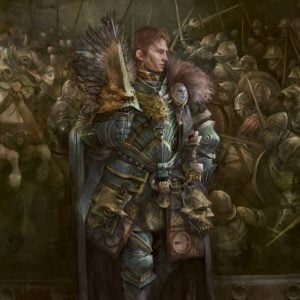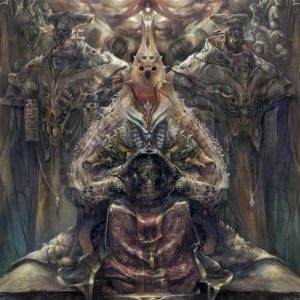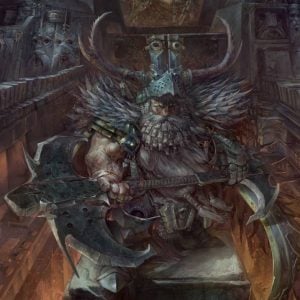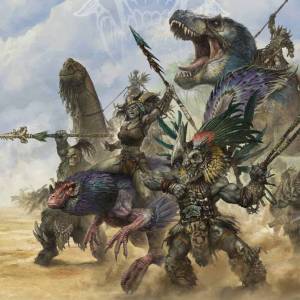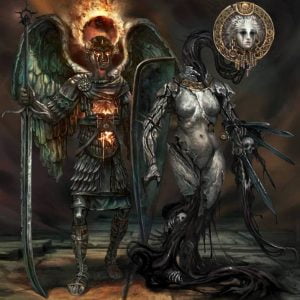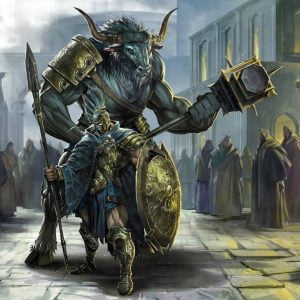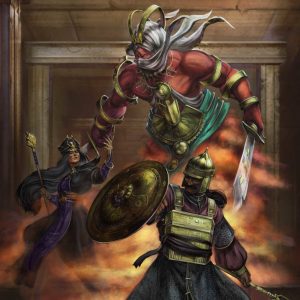
After the foundation of Huenantli, some of the roaming tribes that were forced to abandon the safety of the Mother Oasis, ventured beyond the known lands of the time. Upon reaching the far north of the Wastelands, they came across a vast oasis near the end of the expansive desert; in the middle of the great jungle stood a titanic Spire, which was guarded by an immense beast: Kugur. Kugurr is said to be the largest Apex to ever tread upon Eä, being so large that she was said to blot out the sun when she strode into battle. Although Kugurr’s origins and subsequent deeds are submerged within the realm of myth, W’adrhŭn retellings of her legend claim that she arose deep from within the bowels of the Lithodea Spire, which once stood at the site of today’s Ulakbaat.
It is said that Kugurr slept deeply during the night, sliding into the caverns underneath the ruined Spire. But come morning, her heavy footsteps would cause the oasis to tremble, as she came out to hunt. The colossal predator would not limit herself to feasting on flesh and blood, but began to consume the very oasis itself – devouring large swathes of jungle with each passing day and threatening to unmake the verdant haven entirely. As the cold night gave way to dreaded daytime, the Eclipse gorged itself endlessly, growing ever larger with each cycle.
Desperate and exhausted, the tribes that had migrated to the oasis which surrounded Lithodea found refuge on the edge of the oasis, living in constant fear, not only because the titanic Apex would hunt down and devour anything that she came across, but because day by day, the refuge of the oasis was diminishing. Despite the best efforts of the W’adrhŭn Speakers, Kugurr could not be reasoned with; the great Apex was driven by an all-encompassing, unnatural hunger and nothing else, leaving no room for logic and distinct thoughts.
All hope seemed lost until two twins – Ulaku and Ulaka – decided to thwart the great beast. The siblings, one male and one female, were young and yet tremendously blessed with both razor-sharp wit and unyielding bravery. For the first portion of the plan, the nimble Ulaka slathered herself in liberal amounts of fat and ventured underneath the ruined Spire and into the realm of the Pungaweredi – more commonly known as Carchantulas, outside the W’adrhŭn tongue. The Carchantulas – communal arachnids of truly alarming size that live within Lithodea’s underbelly – had established a fearful alliance with the mighty Kugurr, offering the great predator food, which was caught from their webs, and acting as her lackeys. Reaching the center of the Carchantula subterranean hunting grounds, Ulaka was able to avoid capture due to her greasy, slippery form – gliding and navigating the expansive spiderweb network without an issue in sight.
At the heart of the immense web, the Speaker Ulaka sought to coax the Carchantula Elder Queen out of hiding, tugging on the delicate strands of spider-silk like a harpist might the strings of his instrument. Expecting to feast on entangled prey, the Queen chittered and crawled, heaving her immense bulk to meet the disturbance head-on. Being blind – as is the case with all Carchantulas – Ulaka was able to escape the Queen’s eager fangs, leading her through and around her own web in a pointless chase. The Queen roared and cursed, demanding to know the infiltrator’s true identity. Ulaka, smart as she was, stated that she was an agent of Kugurr – lying that she was sent to test the Queen’s prowess in catching and providing prey for the great Apex. Ulaka expanded her lie, saying that the Eclipse believed the Queen to be incapable of catching victims, having lost her edge due to old age. Furious and desperate to prove the accusations wrong, the Queen paused and started producing webbing of exceptional quality, weaving spider-silk of the purest form in the hope of subduing the intruder and demonstrating her worth. Before she was able to cast her net, Ulaka retrieved a vial of Dilosaur poison from her pouch – which is known for its unparallel pain-inducing properties – and flicked it into the spider’s exposed web glands. The beast, now in a fit of unimaginable pain, was sent reeling back – discarding her silk and fleeing deeper into her domain to shelter her wounds. Ulaka was quick to retrieve the discarded silk, coiling it around her shoulders and making her way towards the surface and to her brother. Due to this act of trickery, it is said all Carchantulas remain forever hostile to this very day – harboring a seething hatred for all W’adrhŭn because of Ulaka’s actions all those years ago.
Upon reaching her brother within the oasis above, Ulaka handed him the precious bundle of spider-silk. Under the vigil of a full moon, Ulaku weaved a veil of unmatched craftsmanship – letting it cure underneath the night sky and imbuing it with shimmering moonlight. Without pause – during the same night, when the Great Apex was sleeping – the twins ventured once again beneath the ruined Spire, following the path towards Kugurr’s lair. There, the twins found the Eclipse amidst a deep slumber; with one swift motion, the spider-silk veil was draped over Kugurr’s head, pushing the great Apex into an eternal night and never-ending sleep. The veil’s moonlit properties – the story goes – have kept Kugurr subdued ever since, binding the legendary beast into an ever-flowing dream that has no end in sight. In honor of the mythical twins, the northernmost oasis was named Ulakbaat – meaning Ulak’s Guile – by the grateful tribes. Yet, legends say that Kugurr might still awaken, rising from deep within the earth, so that she might devour all in her path once more.
Despite the myth of Kugurr’s saga, the tale of Ulakbaat’s founding serves a key practical role within tribal society. The labors of the two twins show the value of wit and calculated guile to young W’adrhŭn, highlighting that force is not always the most preferable solution. The tale of the Eclipse’s downfall showcases the power that lies within inventive thought, fostering that very spirit within the impressionable minds of the young.
Today, Ulakbaat is mostly known for its harvesting of Carchantula spider-silk, with trained poachers collecting the valuable material by targeting and incapacitating the great spiders – much like Ulaka did within the famous tale. The silk has a multitude of useful properties: the organic gel that coats it has notable adhesive and waterproofing properties, and the fibers are immensely tough and flexible, finding extensive use within an array of tribal crafts and disciplines. Additionally, the Cult of Famine has found a specialized use for spider-silk – when it comes to the spread and recording of their many stories. Famine cultists have been known to weave intricate bundles made from the sturdy webbing, creating an assortment of knots within each strand to synthesize a specialized textile form of record keeping. With the additional use of targeted pigmentation, this ‘silk-writing’ – known as Quopiti in the tribal tongue – can be used to reliably record and propagate the many stories of the W’adrhŭn race between oases and tribes alike, making it of invaluable cultural importance.



